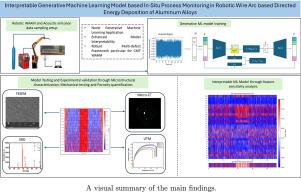基于可解释生成机器学习模型的机器人电弧铝合金定向能沉积原位过程监测
IF 5.4
2区 工程技术
Q2 ENGINEERING, MANUFACTURING
CIRP Journal of Manufacturing Science and Technology
Pub Date : 2025-09-23
DOI:10.1016/j.cirpj.2025.08.010
引用次数: 0
摘要
使用CMT的WA-DED正在成为一种高通量金属AM策略,但它仍然容易受到各种热机械不稳定性和冶金不连续的影响。在这项研究中,我们提出了一种先进的基于声发射的原位监测,利用生成式ML框架来鲁棒地检测和表征损害部件完整性的异常情况。具体来说,我们研究了过流、高行程速度、保护气体流量不足、过流和低保护气体流量组合以及高行程速度和低保护气体流量组合五种临界故障场景,阐明了它们在声学领域的不同特征。一个严格的时间和频域描述符的选择被用来训练变分自编码器,使正常过程状态的准确重建和有效的离群检测。微观结构分析,包括FESEM, Micro-CT和XRD,验证了这些断层对孔隙演化,晶粒形貌和力学性能(如UTS)的不利影响。所提出的VAE模型在多种缺陷类型中表现出稳健的性能,对过流引起的故障的峰值检测准确率为87%,对高行程速度异常的峰值检测准确率为85%,对保护气体流量不足引起的缺陷的峰值检测准确率为81%,对过流和低气体流量联合作用的峰值检测准确率为87%,对高行程速度和低气体流量联合作用的峰值检测准确率为84%。过流异常导致粗柱状晶粒和高孔隙率,而高流速放大了几何不规则性。低气体流量条件促进氧化引起的孔隙度。所提出的方法在检测这些缺陷方面实现了高保真度,强调了数据驱动的重构误差和材料表征之间的协同作用。通过特征敏感性分析,将无监督生成深度学习与领域特定可解释性相结合,这种声学监测范式提供了一种可扩展且经济有效的途径来检测WA-DED制造组件的缺陷并确保结构可靠性。综合实验验证和多物理场相关见解使该框架成为WA-DED现场过程监测的强大框架。本文章由计算机程序翻译,如有差异,请以英文原文为准。

Interpretable generative machine learning model based in-situ process monitoring in robotic wire arc based directed energy deposition of aluminum alloys
WA-DED using CMT is emerging as a high-throughput metal AM strategy, yet it remains susceptible to a variety of thermomechanical instabilities and metallurgical discontinuities. In this study, we present an advanced AE based in-situ monitoring utilizing the generative ML framework to robustly detect and characterize anomalous conditions that compromise part integrity. Specifically, we examine five critical fault scenarios which are overcurrent, high travel speed, insufficient shielding gas flow, combination of overcurrent and low shielding gas flow rate and combination of high travel speed and low shielding gas flow rate elucidate their distinct signatures in the acoustic domain. A rigorous selection of time and frequency domain descriptors is leveraged to train the variational autoencoder, enabling accurate reconstruction of normal process states and efficient outlier detection. Microstructural analyses, encompassing FESEM, Micro-CT, and XRD, validate the detrimental influence of these faults on porosity evolution, grain morphology, and mechanical properties such as UTS. The proposed VAE model demonstrated robust performance across multiple defect types, achieving peak detection accuracies of 87% for overcurrent-induced faults, 85% for high travel speed anomalies, 81% for defects caused by insufficient shielding gas flow, 87% for combined effect of overcurrent and low gas flow rate, and 84% for combined effect of high travel speed and low gas flow rate. Overcurrent anomalies induce coarse columnar grains and high porosity content, while high travel speed amplifies geometric irregularities. Low gas flow conditions foster oxidation induced porosity. The proposed approach achieves high fidelity in detection of these defects, underscoring the synergy between data driven reconstruction errors and material characterization. By integrating unsupervised generative deep learning with domain specific interpretability through feature sensitivity analysis, this acoustic monitoring paradigm provides a scalable and cost effective pathway to detect defects and ensure structural reliability in WA-DED manufactured components. The comprehensive experimental validations and multi-physics correlational insights position this framework as a robust framework for in-situ process monitoring in WA-DED.
求助全文
通过发布文献求助,成功后即可免费获取论文全文。
去求助
来源期刊

CIRP Journal of Manufacturing Science and Technology
Engineering-Industrial and Manufacturing Engineering
CiteScore
9.10
自引率
6.20%
发文量
166
审稿时长
63 days
期刊介绍:
The CIRP Journal of Manufacturing Science and Technology (CIRP-JMST) publishes fundamental papers on manufacturing processes, production equipment and automation, product design, manufacturing systems and production organisations up to the level of the production networks, including all the related technical, human and economic factors. Preference is given to contributions describing research results whose feasibility has been demonstrated either in a laboratory or in the industrial praxis. Case studies and review papers on specific issues in manufacturing science and technology are equally encouraged.
 求助内容:
求助内容: 应助结果提醒方式:
应助结果提醒方式:


